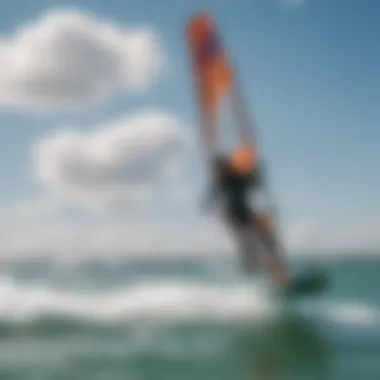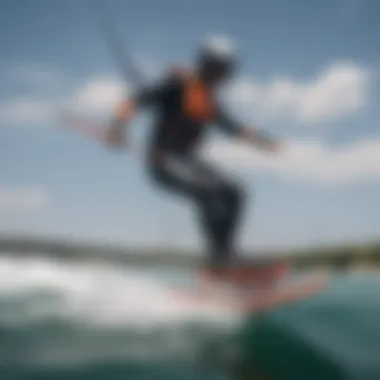Liquid Force Hydrofoil Technology in Kiteboarding


Intro
Kiteboarding has seen a myriad of changes over the years, but the introduction of hydrofoil technology has truly turned the tides. Liquid Force, a significant player in the kiteboarding realm, has championed this advancement, allowing riders to soar above the water like never before. Understanding the dynamics at play with hydrofoil technology not only enhances performance but also opens up new avenues for exploration in the sport. This article aims to dissect the core concepts behind Liquid Force's hydrofoil technology, detailing the ins and outs that can make or break your kiteboarding experience.
By delving into the principles of hydrodynamics, we will outline how these elements contribute to the improved capabilities of hydrofoils compared to traditional boards. This overview will be beneficial for seasoned kiteboarders looking to refine their technique, as well as newcomers curious about the evolving landscape of kiteboarding.
As we continue, we'll spotlight the latest gear offerings from Liquid Force, explore advanced tricks and safety practices, and paint a picture of where the future might take this exhilarating sport. Let’s dive in!
Intro to Hydrofoil Technology
The emergence of hydrofoil technology has reshaped the dynamics of various water sports, prominently kiteboarding. Understanding hydrofoils is crucial for practitioners and enthusiasts alike, as this innovation not only alters how riders interact with water but also enhances performance significantly. The implementation of hydrofoil technology marks a pivotal transformation in the kiteboarding experience, allowing riders to glide smoothly over the surface of the water, drastically decreasing drag and improving speed.
The benefits associated with hydrofoil boards are manifold and can enhance nearly every aspect of riding. For starters, hydrofoil boards lift above the water, enabling riders to traverse choppy waters without sacrificing speed or control. This advancement means that even less-than-ideal conditions can be transformed into exhilarating experiences. Additionally, the ability to ride on a hydrofoil allows for a more efficient use of wind, granting users the potential to ride for hours without tiring.
Moreover, the introduction of hydrofoil technology in kiteboarding has opened doors to a wider audience of adventurers and hobbyists. With the right equipment and understanding, novices can quickly grasp the fundamentals, paving the way for more individuals to enjoy the thrill of kiteboarding. Safety measures and innovations in equipment design have made hydrofoiling more accessible than ever.
The intricacies of hydrofoils—how they are constructed, how they function, and their performance capabilities—offer much to explore. A closer inspection of hydrofoil technology illuminates its influence on kiteboarding, thus presenting key insights into how it enriches the sport. Ultimately, by delving into the specifics of hydrofoils, this article aims to equip both seasoned kiteboarders and curious newcomers with a better understanding of this exciting technology.
Definition of Hydrofoils
Hydrofoils are specialized underwater wings attached to a kiteboard that generate lift as the board moves through the water. The principle behind the effectiveness of hydrofoils lies in Bernoulli's principle, where the shape of the foil creates varying water pressure on either side, enabling the board to rise above the surface. This lift reduces drag significantly, allowing the rider to achieve higher speeds with less effort.
History of Hydrofoils in Watersports
The concept of hydrofoils isn't new; it has roots stretching back to the early 1900s, when inventor Alexander Graham Bell experimented with the design. However, it wasn't until the latter part of the 20th century that hydrofoils began making waves in watersports. Over the years, the technology has evolved from niche applications in racing sailboats to a mainstream choice in kiteboarding and other water sports.
As innovations continued to brew, hydrofoils found their way into diverse watercraft, from surfboards to racing yachts. In kiteboarding specifically, Liquid Force has played a pivotal role in advancing the technology, consistently pushing the envelope with research and development. The evolution of hydrofoils has mirrored the growing enthusiasm for kiteboarding, culminating in a sophisticated balance of design and functionality that allows riders to enjoy the thrill of gliding with unmatched ease.
In summary, hydrofoil technology represents an exciting frontier in kiteboarding, offering significant advantages that challenge conventional approaches to riding. Understanding the historical context and definitions surrounding hydrofoils allows for a deeper appreciation of their role in shaping the future of this thrilling sport.
Understanding Liquid Force
Liquid Force has carved a notable niche within the realm of kiteboarding, primarily due to its commitment to innovation and performance. Understanding this brand provides crucial context about how hydrofoil technology has been integrated into the sport, revolutionizing the way enthusiasts engage with water. The perks and insights to be gleaned from their approach also extend to those already participating in kiteboarding as well as newcomers eager to dip their toes into the water.
Company Overview
Founded with a passion for water sports, Liquid Force began its journey in the early 1990s. The company's founders envisioned a brand that not only produced high-quality gear but also fostered a culture around kiteboarding. Over the years, Liquid Force has shifted its focus to cutting-edge hydrofoil technology, understanding that progress in this area can dramatically enhance performance.
Liquid Force hydrofoils are designed with precision to reduce drag and enhance lift. This dynamic feature makes them stand out in the competitive market. By collaborating with experienced riders and engineers, Liquid Force ensures its products are tested and refined under real-world conditions. This real-time feedback loop helps guarantee that the gear caters to the demands of both seasoned kiteboarders and novices.
Key Features of Liquid Force Hydrofoils:
- Aerodynamic designs: These are crafted to optimize fluid dynamics for better performance.
- Durable materials: The products are made from high-grade materials ensuring longevity in harsh conditions.
- User-friendly models that cater to various skill levels.
Philosophy of Innovation
At the heart of Liquid Force’s operations lies a strong philosophy of innovation. The brand believes that true advancement comes through continuous research, testing, and adaptation. The goal isn't just making products that look good on the shelf, but those that redefine the experience of kiteboarding.
Liquid Force takes an interdisciplinary approach to innovation, integrating insights from gear design, human biomechanics, and hydrodynamics. This comprehensive strategy has led to groundbreaking features in their hydrofoil lines, turning heads and raising eyebrows in the industry.
"Innovation is not just what we do; it’s how we think. Every new kiteboard or hydrofoil is a chance to push the envelope a little further."
To illustrate, the latest creations by Liquid Force showcase advanced features like adjustable aspects in the hydrofoils designed to meet an array of riding styles. These adaptations enable riders to personalize their experience, adapting their equipment to varying conditions or personal preferences.
The commitment to staying ahead of the curve in hydrofoil technology not only enhances the speed and stability of kiteboarding but also widens its appeal. Individuals who may have overlooked the sport due to perceived complexities can find that the innovations in Liquid Force products have made it more accessible than ever. This mix of creativity and practicality forms the backbone of their drive to lead in kiteboarding evolution.
The Science of Hydrodynamics


Hydrodynamics is the study of fluids in motion and plays a pivotal role in kiteboarding, particularly when it comes to hydrofoil technology. Understanding these principles can significantly enhance a kiteboarder's performance on the water. The interaction between water and the hydrofoil shape determines everything from speed to maneuverability, making this knowledge essential for enthusiasts and professionals alike. In this section, we will break down the basic principles of fluid dynamics as they relate to hydrofoils, as well as explore lift and drag concepts that are crucial to mastering this technology.
Basic Principles of Fluid Dynamics
At the core of hydrodynamics are a few basic principles that kiteboarders must grasp to fully appreciate hydrofoil performance. Firstly, fluid dynamics examines how forces act on objects within a fluid, typically governed by Newton's laws of motion. For kiteboarders, the key aspects to focus on include:
- Continuity Equation: Fluid flowing through a confined space will speed up when it reaches a narrower section. This principle helps explain how hydrofoils achieve lift—it’s all about manipulating water flow.
- Bernoulli's Principle: This posits that as the speed of a fluid increases, its pressure decreases. The contrast in pressure above and below a foil creates lift, which is critical for the hydrofoil to rise out of the water.
- Viscosity: This term refers to the thickness or stickiness of the fluid. The higher the viscosity, the more resistance an object will experience. For kiteboarders, minimizing drag and increasing speed involves considering the viscosity of seawater versus fresh water.
By understanding these dynamics, kiteboarders can make informed decisions about board selection and technique, affecting their overall experience.
Lift and Drag Concepts
Lift and drag are fundamental forces impacting the performance of hydrofoil boards. Mastering these forces is crucial for anyone looking to enhance their kiteboarding skills.
- Lift: The force that allows the hydrofoil to rise out of the water is generated mainly through the shape and angle of attack of the foil. When a hydrofoil is oriented correctly, water flows faster over the top than the bottom, creating a pressure differential which lifts the board upwards.
- Drag: This is the resistance experienced when an object moves through a fluid. In kiteboarding, minimizing drag is key to achieving higher speeds. There are two types of drag to consider:
- Form Drag: Related to the shape of the hydrofoil. Sleeker, more aerodynamic shapes reduce form drag, allowing for a smoother ride.
- Friction Drag: Caused by the surface of the board interacting with water. The smoother the surface, the less friction, which translates to better performance.
By optimizing both lift and drag, kiteboarders can dramatically improve their riding experience, resulting in smoother glides and quicker accelerations.
Understanding hydrodynamics and the forces acting on hydrofoils can make all the difference for kiteboarders seeking outstanding performance on the water.
Mastering these principles not only enhances personal skills but also fosters a deeper appreciation for the science that underpins the sport. As kiteboarding continues to evolve, so too will strategies leveraging this fundamental understanding of fluid dynamics.
Advantages of Hydrofoil Boards
When it comes to kiteboarding, the discussion around hydrofoil boards often revolves around their distinct advantages over traditional boards. For enthusiasts and professionals alike, understanding these benefits can make a significant difference in performance and overall enjoyment of the sport. Whether you're an experienced kiteboarder looking to boost your speed or a newcomer curious about the potential of hydrofoils, grasping the advantages of these boards is essential.
Improved Performance and Speed
One of the standout features of hydrofoil boards is their ability to significantly enhance speed. When a kiteboarder takes advantage of hydrofoil technology, they experience a relatively unique sensation—the feeling of gliding above the surface of the water. This is primarily due to the lift generated by the hydrofoil. It acts somewhat like an airplane wing, allowing the board to rise above the water, reducing the drag that traditional boards often encounter.
The resultant speed gain can be quite pronounced. Riders often find themselves accelerating quicker than ever before. For instance, a session on a Liquid Force hydrofoil can result in speeds that are typically 20–30% faster compared to conventional boards. As any kiteboarder knows, this quick burst can lead to exhilarating experiences on the water.
"Hydrofoil boards are not just a trend; they redefine the potential of kiteboarding."
Enhanced Stability and Control
Another critical advantage lies in the stability that hydrofoil boards offer. By lifting the board above the water's surface, riders experience a smoother ride, unaffected by choppy waters or surface irregularities. This stability allows for greater control, especially in challenging conditions. For kiteboarders who prefer to push their limits, hydrofoils facilitate carving and maneuvering with remarkable ease, creating a more enjoyable riding experience.
Riders have noted that with the right technique and practice, transitioning to a hydrofoil board can mean maintaining better control at higher speeds. Essentially, the enhanced control comes from the balanced design of the hydrofoil itself. As you gain proficiency, you can handle turns and jumps more gracefully than on a traditional board, which can feel cumbersome in rough conditions.
Reduced Water Resistance
Water resistance is a common challenge faced by kiteboarders. Traditional boards can experience significant drag, especially as the speed increases. Here, hydrofoil boards shine once again. By rising out of the water, they minimize the wetted surface area, thus drastically reducing the resistance that conventional boards must overcome.
This lower water resistance means that hydrofoil boards require less effort to achieve and maintain high speeds. Consequently, riders can enjoy longer sessions on the water without tiring as quickly. This aspect is particularly appealing for those exploring new spots or striving to extend their rides.
Kiteboarding with Hydrofoils
The integration of hydrofoils into kiteboarding has revolutionized how enthusiasts engage with the sport. As kiteboarding evolves, the emergence of hydrofoil technology stands out distinctly, offering a bridge between traditional riding styles and cutting-edge performance enhancements. Understanding how to effectively utilize hydrofoils can dramatically enhance both the thrill and efficiency of riding, making it an essential topic for both seasoned riders and novices eager to dive into this exciting realm.
Techniques for Effective Use
Mastering hydrofoil kiteboarding requires a nuanced approach. Compared to traditional boards, hydrofoils differ significantly in their handling and performance dynamics. Here are some critical techniques to maximize the potential of hydrofoil riding:
- Proper Positioning: Maintaining the right stance is vital. Riders need to keep their weight centered over the foil, which may feel a tad strange at first. Standing too far back can lead to excessive porpoising, while leaning too far forward could result in a sudden crash.
- Smooth Transitions: When launching or landing, smoothness is the name of the game. Abrupt movements can upset the balance of the foil, leaving riders struggling to regain control. Practicing gradual weight shifts can lead to a seamless experience, especially during light wind conditions.
- Kite Handling: The kite plays a significant role in hydrofoil riding. Riders should aim to fly the kite higher in the window, allowing more lift for the foil. This helps in reducing drag and improving glide, making it easier to maintain speed during transitions.
- Balance and Coordination: Developing a keen sense of balance is critical. As the board lifts above the water, the feeling changes drastically from riding on a traditional board. Engaging the core and learning to work with the foil's movements will prepare riders to tackle various conditions more adeptly.
Riders must practice these techniques consistently to become proficient. Hydrofoiling offers a unique challenge, but with perseverance, it becomes second nature.


Selecting the Right Conditions
Choosing the appropriate conditions is another essential facet of hydrofoil kiteboarding. Unlike traditional riding, hydrofoils can enable kiteboarders to ride in lighter winds and shallower waters, yet there are still critical factors to consider:
- Wind Speed: Ideally, wind speeds between 12 to 20 knots are perfect for learning. These conditions allow the kite to generate sufficient power without overwhelming the rider. Light winds, particularly around 10 knots, can be ideal for advanced riders.
- Water Surface: Flat water is incredibly forgiving for hydrofoil practice. It allows for a smoother ride, aiding new practitioners in developing their skills. Choppy water can create added instability, making it daunting to handle the kite and foil simultaneously.
- Weather Conditions: Riders should always check the weather patterns. Clear forecasts and less turbulent conditions ensure better experience, keeping safety at the forefront. A stable atmosphere with minimal gusts helps maintain control and confidence while riding.
"The right conditions can make or break your foling experience, so it pays to do your homework before heading out."
- Personal Skill Level: Always align conditions with one's skill level. For beginners, calmer waters and moderate winds are crucial for building confidence. Advanced riders may seek more challenging conditions, pushing their limits and refining their skills further.
Ultimately, the combination of proper techniques and the right conditions can lead to an enlightening experience. This harmony between equipment mastery and environmental awareness empowers kiteboarders to harness the full potential of hydrofoil technology.
Latest Innovations in Liquid Force Hydrofoils
The landscape of kiteboarding is continually shifting, and Liquid Force hydrofoil technology stands at the forefront of these changes. The importance of this section can't be understated, as innovations often lead to new pathways in performance, safety, and accessibility. The primary focus here is on how advancing design and materials contribute to the overall evolution of hydrofoils. This not only enriches the experience for current kiteboarders but also beckons newcomers to explore this exhilarating sport.
Design Advances
In the world of hydrofoiling, design plays a crucial role. Liquid Force has pushed the envelope with their cutting-edge designs that not only enhance aesthetics but vastly improve functionality.
- Wing Shapes: The shapes of the wings have been optimized for various conditions, reducing drag while enhancing lift. Specific contours allow for smoother transitions from surface riding to being airborne.
- Adjustable Foil Height: Recent models come with adjustable heights, giving riders the ability to modify their setup based on water conditions. This adaptability makes it easier for novices and experts alike to tailor their equipment to changing circumstances.
- Streamlined Profiles: Engineers are constantly working to reduce drag. The newer profiles have streamlined edges that cut through the water more effectively, making for a smoother ride.
These design advancements are not just about making the boards prettier; they fundamentally impact performance. Riders can achieve higher speeds with less effort, which translates to longer sessions and a more enjoyable overall experience.
"Good design isn’t just about appearance; it’s one of the core fundamentals for performance."
Material Developments
Material choice is another vital aspect in the evolution of Liquid Force hydrofoils. Innovations here have made boards lighter, stronger, and more durable, which leads to improved performance over time.
- Carbon Fiber Integration: This lightweight material has become a game-changer, allowing riders to handle their boards with ease while still maintaining high strength. The stiff yet flexible nature of carbon fiber gives the boards a vibrant feel on the water.
- Epoxy Resins: New developments in epoxy resins provide a sturdy structure while still being lightweight. This is crucial for reducing overall weight without sacrificing durability.
- Recyclable Materials: More attention is being paid to sustainability. Liquid Force is exploring recyclable materials that maintain performance levels, appealing to an eco-conscious audience.
These advancements in materials not only enhance the riding experience but also promise longevity and sustainability in equipment. Having a gear that lasts longer and performs better not only saves money in the long run but also contributes to greater enjoyment in every session.
In summary, the latest innovations in Liquid Force hydrofoils focus on both design and materials, pushing the boundaries of what is possible in kiteboarding. Catching up with these advancements is essential for anyone serious about their craft.
Safety Considerations
Safety plays a pivotal role in the realm of hydrofoiling, where the thrill of gliding above water comes with its own share of risks. Understanding these safety considerations is not only crucial for those new to the sport but also benefits seasoned kiteboarders looking to enhance their riding experience.
Kiteboarding, while exhilarating, involves navigating through both natural elements and mechanical nuances. The unique dynamics introduced by hydrofoils change the way riders interact with the water and air. This shift elevates the importance of safety protocols.
Understanding Risks Involved
Getting to grips with the various risks associated with hydrofoil kiteboarding can be the difference between a fun day on the water and a serious accident. A few major considerations include:
- Injury from Falls: Falling while hydrofoiling can lead to injuries, particularly if one falls at high speed or at a precarious angle. Unlike traditional kiteboarding, where the board remains close to the water, hydrofoils can lift the rider higher, resulting in a more severe fall.
- Turbulence and Wind: The nature of kiteboarding relies heavily on wind conditions. Sudden gusts can destabilize the hydrofoil, causing unpredictable maneuvering that can create hazards.
- Collisions with Obstacles: Whether it's a boat or a buoy, obstacles in the water can pose serious risks. Hydrofoiling's higher speeds mean less reaction time for avoiding such hazards.
- Equipment Failure: With advanced technology like hydrofoils comes the need for regular maintenance. A malfunction in the gear, particularly in the foiling mechanism, can lead to significant accidents.
"Foresight is the best safety. Knowing the potential risks enhances your riding skills and keeps you secure for future rides."
Best Practices for Safe Riding
Practicing proven safety measures can mitigate many of the risks associated with hydrofoils. Here are some essential tips for kiteboarders aiming to ride safely:
- Wear Protective Gear: Always don a helmet and impact vest. These can protect you from head injuries and minimize the effects of falls.
- Conduct Equipment Checks: Before hitting the water, perform a thorough inspection of your gear. Look out for frayed lines, damage to the foil, and ensure all connections are secure.
- Practice in Controlled Conditions: Start out in mild wind and calm water. This allows new riders to get used to the unique sensations of hydrofoiling with a lower risk of complications.
- Be Aware of Surroundings: Maintain vigilance of other water users, including swimmers and boats. Always keep an eye on conditions that may change unexpectedly.
- Take a Lesson: If you’re new to hydrofoiling, consider working with a certified instructor. Their expertise can offer invaluable insights that can contribute to a rider's safety and enjoyment.
- Know Your Limits: Recognizing your skill level is paramount. Avoid pushing yourself into conditions that may exceed your current ability, as this can lead to accidents.
Implementing these practices can foster not just a safer riding environment but also a more enjoyable hydrofoiling experience overall. Everyone should leave the water with a smile rather than a story of mishaps.


Accessibility of Hydrofoiling
In the modern landscape of kiteboarding, the importance of accessibility cannot be overstated. Both seasoned enthusiasts and newcomers alike should find entry points into the sport that don’t feel like climbing Mount Everest. The integration of hydrofoil technology in kiteboarding is doing just that, breaking down barriers that often keep potential practitioners at bay. Accessibility in this context not only refers to physical entry into the sport but also encompasses skill acquisition, affordability, and fostering inclusivity in diverse communities.
Expanding the Sport to New Practitioners
Hydrofoil technology is like a breath of fresh air for kiteboarding. It's offering unprecedented opportunities for those who once thought kiteboarding was beyond their reach. For starters, the unique advantage of hydrofoils is that they reduce water resistance, allowing riders to glide smoothly over the surface, even in light wind conditions. This means that those living in regions with variable wind patterns can now enjoy the thrill of kiteboarding with relative ease.
For new practitioners, this technology can simplify the learning curve. Initially, many individuals may feel overwhelmed by the dynamics of kite control and board balance. Hydrofoils provide more stability and lift, enabling learners to find their footing quickly and confidently. Here are some elements that illustrate the impact of accessibility:
- Community Workshops: Many local schools and clubs are hosting workshops that specifically target newcomers, offering hands-on experiences with hydrofoil setups.
- Demo Days: Brands like Liquid Force often organize demo days, allowing prospective riders to test hydrofoil boards without any financial commitment.
- Instructional Videos: Online platforms are filled with educational content, emphasizing easy-to-follow techniques on using hydrofoils, which helps demystify the process.
Through initiatives like these, hydrofoiling breaks free from the insular nature of traditional kiteboarding, inviting a broader range of practitioners into the fold.
Adaptations for Diverse Skill Levels
The beauty of hydrofoiling is its versatility. Regardless of whether you’re a rookie or an old hand on the water, adaptations can be made to meet skill levels. These adaptations enhance the overall learning experience and encourage continual engagement with the sport. Here are some noteworthy considerations to keep in mind:
- Varied Board Designs: Liquid Force has developed different hydrofoils tailored for varying skill levels. Beginners might lean towards boards with a larger surface area for added stability, whereas advanced kiteboarders might prefer smaller, more agile boards that enhance trick performance.
- Customizable Settings: An often overlooked aspect is the ability to adjust settings on a hydrofoil. New riders can start with a higher front foil placement, which will help moments of balance and control. As skills grow, the setup can be fine-tuned for a more challenging ride.
- Integrated Safety Features: Contemporary hydrofoils come equipped with safety designs such as breakaway systems and impact-resistant materials. These features are beneficial for new riders who are still navigating the waters of kiteboarding.
- Incremental Learning: By progressing from small, controlled environments to larger open water, individuals can gradually understand the nuances of riding a hydrofoil. This step-by-step approach prevents overwhelming new practitioners and gradually builds their confidence.
In summary, the advances in hydrofoil technology ease the journey into kiteboarding for everyone, encouraging widespread participation and reigniting a passion for the sport among existing enthusiasts. It is vital for industry players, whether manufacturers or local schools, to acknowledge these needs and advocate for a more inclusive approach to kiteboarding. As participation expands, the kiteboarding community can look forward to a diverse and vibrant future.
The Future of Hydrofoil Technology
The future of hydrofoil technology holds a significant place in the evolution of kiteboarding. With the advancements in materials and design, as well as the growing popularity of the sport, the potential for hydrofoils is expanding rapidly. Kiteboarders are becoming more adventurous, eager to push the boundaries of what they can do on water. As this trend grows, manufacturers like Liquid Force are diving deep into research and development, ensuring that the products not just meet but exceed the needs of riders.
Specific Elements to Consider:
- Sustainability: The shift towards more sustainable materials for hydrofoils is a growing priority. As environmental consciousness increases among riders and manufacturers alike, the focus is shifting toward ethical sourcing and construction processes.
- User-Friendly Designs: Expect future hydrofoils to incorporate user-friendly features, making it easier for newcomers to grasp the sport. Enhanced stability and intuitive controls are on the horizon, narrowing the gap between skill levels.
- Increased Versatility: New innovations are aiming for versatility in hydrofoil designs. Riders want to transition smoothly from hydrofoiling to traditional kiteboarding setups, enjoying the best of both worlds without needing multiple boards.
- Connectivity: Integration of technology, like smart sensors or tracking devices, has begun to take a front-row seat in the design process. Imagine receiving real-time data analytics on your performance via an app while you ride. This could change how riders approach their training and enjoyment of the sport altogether.
Emerging Trends
Emerging trends in hydrofoil technology indicate a fascinating crossroad between performance and recreational use. Kiteboarders are constantly on the lookout for equipment that not only elevates their experience but also enhances their safety.
- Hybrid Models: There's an increasing demand for hybrid hydrofoils that switch effortlessly between different riding styles. These models are designed to tackle diverse conditions, from calm lakes to choppy seas, allowing riders to adapt seamlessly.
- Advanced Aerodynamics: Innovative designs incorporating advanced aerodynamic principles are enhancing the lift-to-drag ratios. This means better speed and efficiency, allowing riders to cruise with less effort.
- Customization Options: Many brands, including Liquid Force, are introducing customizable features to cater to personal preferences. From color selections to adjustable sizes, riders will have the freedom to tailor their equipment.
"Understanding the nuances of hydrofoil dynamics will be crucial for future generations of kiteboarders. The technology isn't just changing the sport—it's redefining it."
Innovative Applications Beyond Kiteboarding
The future of hydrofoil technology isn't merely limited to kiteboarding. As industries evolve, applications are cropping up in various areas, hinting at a future where hydrofoils might reconfigure the very nature of water sports.
- Surfing: Hydrofoils are already making waves in surfing. Surfboards integrated with hydrofoil systems allow surfers to ride the smallest of swells, gliding above the water surface to maximize enjoyment.
- Wakeboarding: The wakeboarding community has embraced hydrofoil tech too. By reducing drag, wakeboarding with hydrofoils offers riders a chance to catch wakes more effortlessly, leading to new tricks and maneuvers.
- Marine Transportation: Beyond the realm of sports, hydrofoil technology is finding its way into commercial maritime transportation. Companies are testing hydrofoil ferries that can travel faster and more smoothly than conventional vessels, which might be vital in congested waterways.
- Research and Development in Hydro Dynamics: Scientific exploration into the behaviors of hydrofoils can further influence various applications like military drones or environmental monitoring devices that need precise movement over water surfaces.
As we look ahead, the burgeoning advances in hydrofoil technology reveal the endless possibilities that lie before us. Whether through kiteboarding or other aquatic uses, the approach to water sports is poised for a true transformation.
Culmination
The conclusion of this exploration into Liquid Force hydrofoil technology in kiteboarding serves as a crucial touchpoint for understanding the multi-faceted advantages this technology offers. It not only draws upon the key insights presented throughout the article but also highlights the transformative potential of hydrofoils in the sport. In a nutshell, what we’ve gathered here points to a unique alignment of innovation, safety, and accessibility that resonates with both seasoned kiteboarders and newcomers.
Summarizing Key Insights
To encapsulate the earlier discussions, hydrofoil technology elevates the kiteboarding experience in several significant ways:
- Performance: The lift generated by hydrofoils allows riders to glide smoothly over the water, resulting in greater speed and reduced drag. Many riders have reported improved overall performance, especially in choppy conditions.
- Stability: The design and mechanics of hydrofoils provide enhanced stability, which is particularly beneficial for beginners or those looking to improve their skills. This added control can be a game-changer, making a seemingly difficult sport more approachable.
- Innovation: Liquid Force continually pushes the envelope with cutting-edge design and material advancements, ensuring that their products not only meet current standards but also pave the way for future breakthroughs.
- Accessibility: Adaptations in design assist a broader range of skill levels to engage with hydrofoil technology, thus expanding the community of kiteboarding enthusiasts.
These points should not just be seen as standalone advantages. Instead, they synergize in a way that redefines what kiteboarding can be. Each rider, whether a hardcore enthusiast or a casual participant, can find value in the insights offered here.
Encouraging Continuous Learning
As kiteboarding evolves, so too should the knowledge and skills of its practitioners. Encouraging continuous learning is essential. Every kiteboarder will benefit from staying informed about the latest advancements, techniques, and safety practices. Here are a few ways to foster this ongoing educational journey:
- Workshops and Clinics: Participating in local kiteboarding clinics or workshops can provide hands-on experience with new techniques and technologies. It’s a chance to learn from experts and fellow enthusiasts.
- Online Communities: Engaging with communities on platforms like Reddit can expose riders to peer insights and collective experiences. Exchanges on platforms like Facebook can also foster discussions around new gear and riding techniques.
- Courses and Certifications: For those serious about improving their skills, considering formal kiteboarding courses or certifications is worthwhile. These programs often incorporate the latest safety protocols and technological advancements.
- Trial and Error: Finally, nothing beats the wisdom gained from experience. Testing different setups, conditions, and techniques will equip riders with insights unique to their style and preferences.
In summary, the narrative of Liquid Force hydrofoil technology is not just about cutting-edge boards. It's about fostering a community where passionate riders continually explore, learn, and elevate their craft. This spirit of inquiry and adaptability will ultimately shape the future of kiteboarding.















